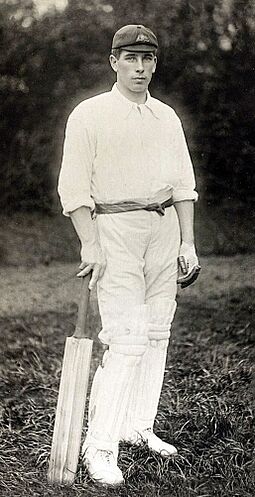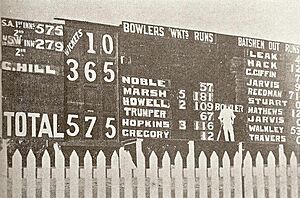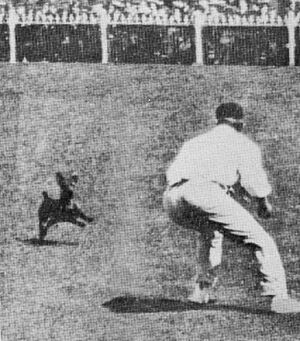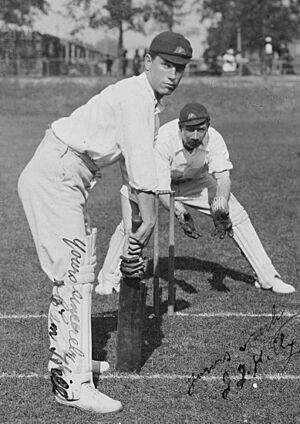Clem Hill facts for kids

Hill in about 1905
|
||||||||||||||||||||||||||||||||||||||||
| Personal information | ||||||||||||||||||||||||||||||||||||||||
|---|---|---|---|---|---|---|---|---|---|---|---|---|---|---|---|---|---|---|---|---|---|---|---|---|---|---|---|---|---|---|---|---|---|---|---|---|---|---|---|---|
| Full name |
Clement Hill
|
|||||||||||||||||||||||||||||||||||||||
| Born | 18 March 1877 Adelaide, Province of South Australia, British Empire |
|||||||||||||||||||||||||||||||||||||||
| Died | 5 September 1945 (aged 68) Parkville, Victoria, Australia |
|||||||||||||||||||||||||||||||||||||||
| Nickname | Kruger | |||||||||||||||||||||||||||||||||||||||
| Height | 1.75 m (5 ft 9 in) | |||||||||||||||||||||||||||||||||||||||
| Batting | Left-handed | |||||||||||||||||||||||||||||||||||||||
| Bowling | Right-arm leg spin | |||||||||||||||||||||||||||||||||||||||
| Role | Batsman | |||||||||||||||||||||||||||||||||||||||
| Relations |
|
|||||||||||||||||||||||||||||||||||||||
| International information | ||||||||||||||||||||||||||||||||||||||||
| National side | ||||||||||||||||||||||||||||||||||||||||
| Test debut (cap 74) | 22 June 1896 v England | |||||||||||||||||||||||||||||||||||||||
| Last Test | 23 February 1912 v England | |||||||||||||||||||||||||||||||||||||||
| Domestic team information | ||||||||||||||||||||||||||||||||||||||||
| Years | Team | |||||||||||||||||||||||||||||||||||||||
| 1892/93–1922/23 | South Australia | |||||||||||||||||||||||||||||||||||||||
| Career statistics | ||||||||||||||||||||||||||||||||||||||||
|
||||||||||||||||||||||||||||||||||||||||
|
Source: CricketArchive, 26 January 2008
|
||||||||||||||||||||||||||||||||||||||||
Clement "Clem" Hill (born 18 March 1877, died 5 September 1945) was an amazing Australian cricket player. He played 49 Test matches as a specialist batsman between 1896 and 1912. He was also the captain of the Australian team in ten Tests, winning half of them.
Clem Hill was a fantastic run scorer. He made 3,412 runs in Test cricket, which was a world record when he retired! His average was 39.21 runs per innings, and he hit seven centuries (scores of 100 runs or more). In 1902, he was the first batsman ever to score 1,000 Test runs in a single year. This amazing feat wasn't repeated for 45 years!
He also set a Sheffield Shield record in 1900–01 by scoring 365 runs for South Australia against New South Wales. This record stood for 27 years. In 2003, a grandstand at the Adelaide Oval was named the "Clem Hill Stand" in his honor. In 2005, he was added to the Australian Cricket Hall of Fame. Many people think Clem Hill was one of the best batsmen of his time.
Clem Hill was a strong left-handed batsman. He had a unique, slightly bent-over batting style. He held the bat low and used his bottom hand strongly. Even with his unusual style, he was very good and fun to watch. He was especially strong at hitting the ball on the leg side and using the cut shot. He could score runs quickly when needed, but he was also known for his patience and strong defence. Hill usually batted at No. 3, and along with Victor Trumper, he was a key player for Australia in the early 1900s. He was also a great outfielder with a powerful throwing arm. His teammates liked him because he was honest, direct, and cheerful.
He played his first big cricket match for South Australia when he was just 16, still a schoolboy. By the time he was 19, he was chosen for the Australian team touring England in 1896, where he played his first Test match. Two years later, at the Melbourne Cricket Ground, Hill scored 188 runs. This was his first Test century and is still the highest score in Ashes Tests by a player under 21. He was named one of the Wisden Cricketers of the Year in 1899.
Clem Hill had some bad luck in 1901–02, getting out for 99, 98, and 97 runs in three Test innings in a row! In total, he was dismissed between 90 and 99 five times in Test cricket. He also holds an Australian Test record for the eighth wicket with Roger Hartigan, scoring 243 runs against England in 1907–08.
Hill sometimes had disagreements with the people in charge of Australian cricket. His Test career ended after some arguments and a boycott in 1912. After he stopped playing cricket, Hill worked in horse racing. He died in 1945 at 68 years old after a tram accident in Melbourne.
Contents
Early Life and First Steps in Cricket
Clem Hill was born on 18 March 1877 in Adelaide, South Australia. His family was very involved in cricket. His father, John Hill, scored a century at the Adelaide Oval, which was a big deal at the time. Clem was one of eight sons, and six of his brothers also played for South Australia. Sometimes, three Hill brothers would play in the same team!
Clem went to Prince Alfred College, a local school. He played his first big school match at 13, starting as a wicket-keeper. But his hands hurt from catching fast balls, so he decided to focus on batting. At 16, he scored an amazing 360 runs in a school match, a new record! Even so, his sports teacher warned him not to play the risky hook shot too much.
Hill played his first major cricket match in March 1893, just after his 16th birthday. He played for South Australia against Western Australia but didn't score any runs in his first innings. In the 1894–95 season, at 17, he played against the touring English team. Later that season, he became a regular player for South Australia in the Sheffield Shield. He scored his first big century (150 not out) against strong English bowlers. People were so excited that one cab driver cheered so much he fell through the roof of his cab! In his first full season, Hill scored 335 runs, averaging almost 48 runs per innings.
Clem Hill was also a talented Australian rules football player. He played for the South Adelaide Football Club for many years.
Becoming a Test Cricketer
First Tours and Big Scores
Clem Hill was the top scorer for South Australia in the 1895–96 season. At first, he wasn't picked for the Australian team to tour England in 1896. But he then scored 206 runs against New South Wales, impressing everyone. Because of public demand, the 19-year-old Hill was added to the team.
He made his Test debut in the First Test at Lord's. He didn't score many runs in that match, and Australia lost the series. However, he scored over 1,000 runs during the whole tour. Wisden Cricketers' Almanack said he was "a brilliant success."
The next series was in Australia in 1897–98. Hill started strong, scoring 200 runs against the touring English team. In the Second Test, he scored 58 runs, helping Australia win. In the Fourth Test in Melbourne, when Australia was in trouble, Hill, only 20 years old, scored an amazing 188 runs. He batted for a long time and gave only one chance to be dismissed. This is still the highest score in Ashes Tests by a player under 21. Australia won the Test and got the Ashes back. That summer, Hill scored over 1,000 runs in a home season, the first Australian to do so.
Amazing Batting and Tough Luck
In 1899, during another tour of England, Hill had surgery on his nose and missed half the tour. But before that, he was seen as the best Australian batsman. He scored 135 runs in the Second Test at Lord's, sharing a great partnership with Victor Trumper. Australia won that Test and kept the Ashes.
In 1900–01, Hill set a new Sheffield Shield record. He batted for over 8 hours and scored 365 runs, including 35 boundaries! This record stood for 27 years. He averaged over 100 runs for the whole season.
When England toured Australia in 1901–02, Hill was the top scorer with 521 runs. He had a very unusual streak, getting out for 99, 98, and 97 runs in three consecutive innings! In one match, he was 98 not out when he hit the ball, and it was caught by a fielder standing on the bicycle track around the field. Hill walked off, even though today it would be six runs and a century. In another innings, at 97, he accidentally knocked a bail off his own stumps, getting himself out. This was very unlucky!
Hill toured England again in 1902. He scored over 1,000 runs for the second time in an English summer. In a Test match at Bramall Lane, on a difficult pitch, Hill scored 119 runs. Australia won that Test. The next two Tests were very exciting, with Australia winning one by just three runs and England winning the last by one wicket. After England, the team went to South Africa, where Hill was the best Australian batsman, scoring 327 runs.
Keeping the Ashes and Record Partnerships
In the 1903–04 series in Australia, England won back the Ashes. Hill had a tough series, not scoring any centuries. In the First Test, there was a big crowd reaction when Hill was given run out. The crowd disagreed with the umpire's decision and threw bottles onto the field.
Hill toured England for the last time in 1905. England kept the Ashes, and Hill was sometimes criticized for hitting the ball too much outside the stumps. However, his fielding was still excellent.
Australia won back the Ashes in 1907–08, winning four Tests to one. In the Third Test in Adelaide, Hill was feeling sick with the flu. But he still managed to bat with Roger Hartigan and set an Australian Test record for the eighth wicket partnership, scoring 243 runs together! Hill scored 160 runs in that innings, helping Australia win.
Captain and End of Career
In 1909, Hill decided not to tour England. This was partly because he disagreed with the new way cricket tours were being managed. He also had a difficult relationship with a cricket official named Peter McAlister.
However, Hill returned to the Test team as captain for a series against South Africa in 1910–11. The South African bowlers had a new style of bowling, using googlys. Hill decided the best way to play them was to hit aggressively. In the First Test, he led the way, scoring 191 runs very quickly. Australia won the series four Tests to one.
Hill was captain again for the 1911–12 series against England. England won the Ashes back. During this series, there were more disagreements between the players and the cricket officials. The players wanted to choose their own team manager for the next tour, but the Board of Control disagreed. Hill was part of a group of senior players who stood up for player rights.
These disagreements led to a big dispute. Hill had a heated argument with Peter McAlister, a fellow selector. This argument led to Hill resigning from the selection committee. He was then invited to play in the 1912 Triangular Tournament in England, but he refused. Five other top players, including Warwick Armstrong and Victor Trumper, also refused. They were known as the "Big Six." This boycott effectively ended Clem Hill's Test career.
Life After Cricket
After his amazing cricket career, Clem Hill returned to play a few first-class matches after World War I. He was 43 years old and wanted to help cricket get started again in Australia.
In total, Hill scored 3,412 runs in Test matches, averaging almost 40 runs per innings, with seven centuries. When he retired, he had scored more Test runs than any other player. This record lasted for 12 years until Jack Hobbs passed it. In 1902, Hill was the first to score 1,000 Test runs in a calendar year. The next person to do this was Denis Compton 45 years later! He also scored over 17,000 runs in Australian state cricket.
In 2003, the South Australian Cricket Association named the new southern grandstand at the Adelaide Oval the "Clem Hill Stand" to honor his contributions. In 2005, he was inducted into the Australian Cricket Hall of Fame.
Outside of cricket, Hill worked in horse racing. He was a steward and later a handicapper, setting the weights for important races like the Caulfield Cup.
Clem Hill married Florence "Florrie" Hart in 1905, and they had two daughters, Lesley and Brenda. In 1945, he was in a traffic accident in Melbourne when he was thrown from a tram. He died soon after at the age of 68. He was buried in North Road Cemetery in Adelaide.
Playing Style and Personality
Clem Hill was a short, strong batsman who could score runs quickly. He was especially brilliant on hard cricket pitches. He had a unique, slightly bent-over batting stance and held the bat low. This made his forward reach shorter, but he made up for it with quick footwork. He was great at the cut shot and hitting powerfully on the leg side. He loved batting against fast bowlers and was fearless when playing the hook shot. He was known for getting out in the "nervous nineties" (scores between 90 and 99) six times in Test matches, including that unlucky streak of 99, 98, and 97.
Wisden, a famous cricket book, said that while Hill could hit hard straight or to the off-side, he mostly scored on the leg side with clever, well-timed shots. His square and late cutting shots were delightful to watch, and his defensive play was admired. He also had endless patience.
Hill was an excellent fielder in the deep with a very powerful throwing arm. In one match, he threw a ball from far away and hit the stumps at both ends! He also made an amazing catch at Old Trafford that people who saw it never forgot.
Clem Hill was known for being a man of high standards and was very popular with his teammates. People described him as pleasant, honest, and direct. There's a story that once, after hitting a shot, he asked the umpire if the ball had been caught. The umpire couldn't see, so Hill asked the fielder, Warren Bardsley, directly. When Bardsley said yes, Hill immediately walked off the field, even though he could have stayed. He didn't care much about his own records. When he saw Jack Hobbs break his record for most Test runs, it was Hobbs' wife who had to remind Hill that the record used to be his!
Images for kids







